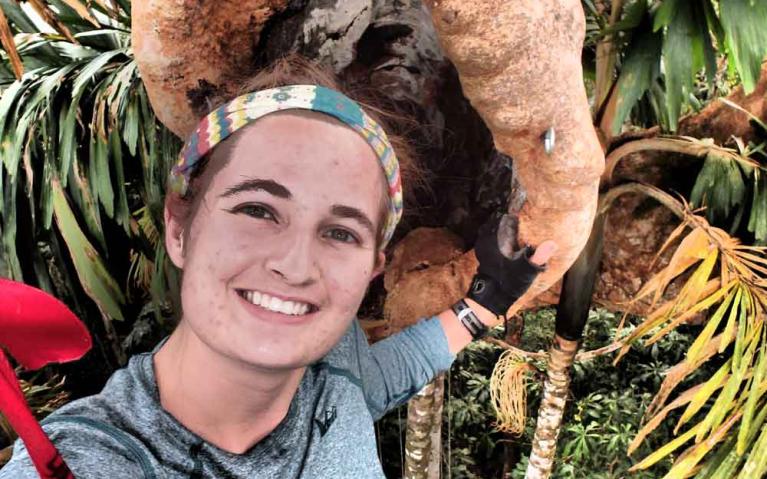
Sofie McComb
Doctor of Philosophy in Forestry (PhD)
Research Topic
Evaluating cumulative impacts to inform effective conservation decisions in a biodiversity hotspot
It is #GreatSupervisor week at UBC! A good time to reflect on those who pour time and energy into our academic journeys. A warm thanks to @TaraGMartin for doing precisely this, and for inspiring those around her with her passion for conservation! #ubcforestry
Dissertations completed in 2010 or later are listed below. Please note that there is a 6-12 month delay to add the latest dissertations.
Tidal freshwater marshes (TFMs) are found within estuaries where freshwater from outflowing rivers becomes mixed with saltwater from inflowing tides. These habitats are relatively rare owing to their limited spatial extent within estuaries, yet are of critical importance for ecosystem services to humans and habitat value to numerous species. Land use changes in the Pacific Northwest of North America have negatively impacted TFMs through persistent stressors such as altered hydrologic regimes which change habitat conditions, and introductions of non-native plant species which displace native plant species. In light of extant degradation and projected impacts under climate change, it is important to understand how the plant communities comprising TFM habitat respond to stressors in order to prevent or remediate habitat loss.This dissertation pairs observational studies of vegetation changes with experimental tests of seed recruitment to understand plant community resilience. In Chapter 2, I used three datasets spanning 40 years to assess plant community resistance to compositional changes, and found that species homogenization of distinct assemblages may be threatening biodiversity. In Chapter 3, I used historical restoration sites to assess plant community resilience following grazing disturbance, and found that non-native, invasive species competitively exclude native species recovery. In Chapter 4, I used a novel experimental mesocosm to estimate recruitment rate of five plant species in relation to tidal elevation/gradient. I found that successful germination is low overall, and each species’ germination rates are restricted to very specific tidal elevations.Together, these insights serve to inform conservation practice by providing case examples of plant community changes under different disturbance contexts. Additionally, understanding the species composition and abundance in seed banks is useful for generating new questions to test plant community response to disturbance. The prevalent conservation practice of setting aside land is often assumed to be sufficient to maintain native or ‘natural’ habitat. However, this research shows the potential for negative habitat changes occurring in TFM plant communities in the absence of management intervention. Practical interpretation of this dissertation highlights the urgency for active management of protected and restored habitats to improve plant community resilience, in the face of multiple stressors.
View record
Theses completed in 2010 or later are listed below. Please note that there is a 6-12 month delay to add the latest theses.
Pacific sand lance (Ammodytes personatus) are a small forage fish that play a significant role in the nearshore ecosystems of the Salish Sea, a highly biodiverse and densely populated inland sea in the northeast Pacific Ocean. Despite this important role, sand lance are data deficient. Little information about the species' habitat distribution, population status, and the threats it faces are available across their entire range making management and policy decisions difficult. Concerned conservation organizations and scientists throughout the Salish Sea, have been gathering observations of sand lance and other forage fish species since 2001. Increasing participation in community science surveys for intertidal Pacific sand lance spawning habitat has resulted in the detection of eggs on >90 beaches in the Canadian Salish Sea between 2001 and 2021. Using these data, I developed a Maximum Entropy (MaxEnt) habitat suitability model and found that less than 6% of the intertidal zone of the Canadian Salish Sea is likely to provide suitable spawning habitat for sand lance. To better understand how to conserve this species and their limited and rare habitat, I worked with 38 experts to conduct a population and vulnerability assessment for Salish Sea sand lance via a three-part structured expert elicitation. Under ‘business as usual’ the survey results suggest sand lance populations are in decline and impacts associated with climate change, pollution, and human development consistently ranked as the highest threats of concern.
View record
Garry oak and associated ecosystems (GOAE) are culturally and ecologically significant landscapes home to over 100 species-at-risk. Less than 5% of GOAE’s original extent remains in Canada, much of which is found on the Gulf Islands, within the Salish Sea of British Columbia. Due to reduced predation and hunting on the Gulf Islands, native black-tailed deer have become hyperabundant and are reshaping plant and animal communities. To guide the management, restoration and protection of these endangered ecosystems, this thesis examines the impacts of deer on a key group of native pollinators within GOAE, bumblebees. Globally bumblebees are in decline, and to date, the role of deer browsing in contributing to their decline has not been explored in GOAEs. I tested the hypothesis that deer browsing has an indirect impact on bumblebee populations through their direct negative impact on floral communities. I surveyed deer density, floral communities, and bumblebee abundances across ten islands with and without deer in the Salish Sea. I found that deer had a negative effect on the abundance of flowering plants, especially native species, and had an indirect negative impact on female bumblebees. These results clearly support the call for urgent deer management, so I then used these results in a structured decision making process to evaluate deer management options for the region. Following a structured decision process with 11 Garry oak ecosystem and deer experts we determined management objectives, management strategies, and the estimated benefit of each strategy. We developed 5 discrete strategies and 4 combinations of strategies to achieve different objectives – maximizing ecological integrity, maximizing the socio-political and technical feasibility of strategies, and minimizing costs. Results revealed that: 1) contract hunting had the highest estimated ecological benefit, 2) benefits were higher on smaller, less inhabited islands, and 3) birth control had the lowest estimated effectiveness. These results were used in tandem with estimated cost data to calculate final cost-effectiveness scores and prioritize the strategies. The top two cost-effective strategies were contract hunting, and the portfolio combination of contract hunting, Indigenous-led hunting, and improved predator viability, with estimated costs of $1.8Million and $2.3Million respectively.
View record
Loss of connectivity caused by anthropogenic barriers is a key threat for migratory freshwater species, barriers on streams can decrease the amount of habitat available for spawning and rearing. To set appropriate targets for restoration it is important to know how different populations have been impacted in terms of the location and extent of historically available habitat that has been lost or has become inaccessible. I mapped and predicted barriers to fish passage in streams and diking infrastructure to estimate the amount of floodplain and stream habitat that remains for 14 populations of salmon in the Lower Fraser River, British Columbia, Canada’s most productive salmon river. To place these estimates within a historical context, the floodplain area was estimated using vegetation records from the 1850’s, and lost streams were estimated. Accessibility to floodplain was poor across the entire region with only 15% of the historical floodplain remaining accessible. Linear stream habitat ranged in accessibility from 28-99% across populations. I used conservation planning software to maximize the amount and quality of stream habitat that can be restored across a range of budgets. An estimated 75% of habitat blocked by barriers could have access restored with an investment of 200 million dollars. With small budgets it was more efficient to remove a high number of culverts, but when budgets were larger, restoration included restoring passage past dams and flood infrastructure. The amount of habitat restored for each species varied depending on whether habitat quality was also prioritized, highlighting where restoration of freshwater habitat requires more than the removal of barriers.
View record
Invasive species represent a significant and growing threat to biodiversity in ecosystems around the world. Research that can address key knowledge gaps is invaluable, particularly as managers grapple with diminishing time, resources, and data to deal with species invasions. Non-native narrow-leaved cattail (Typha angustifolia) is a wetland invader that has been detected in western Canada’s Fraser River Estuary (FRE) in recent decades, but questions around their degree of establishment, impact, manageability, and the potential emergence of invasive hybrid cattail (Typha x glauca), remain unanswered. This research aimed to address these knowledge gaps, investigating the threat potential of these taxa. Using a spectral analysis of aerial imagery, I found that invasive cattails are widespread, currently occupying approximately 4% of FRE marshes. Though never formally recorded in the FRE, T. x glauca is more abundant than T. angustifolia, and likely went undetected due to its cryptic nature. A species distribution model for invasive cattail predicted that 28% and 21% of the FRE has suitability (establishment and persistence) and susceptibility (risk of colonization when suitable) probabilities of > 50% respectively, indicating this invasion is likely to continue. Restoration projects were invasion hotspots, with proportionally more cattail, susceptible habitat, and suitable habitat than the overall estuary. Vegetation sampling demonstrated that cattail-invaded marshes contained lower richness and diversity than uninvaded habitats. Cattail leaf litter had a significant negative effect on richness and diversity, while ramet density and foliar cover did not, suggesting litter may be an important dominance mechanism behind this invasion. Results from a two-year management experiment suggest these impacts may be counteracted, but not without expending considerable resources. Belowground energy reserves declined in response to cutting, however cattail ramets remained unchanged or increased in abundance. Native plant communities have yet to respond significantly to cutting and litter removal, suggesting that more time may be required for their recovery. I conclude that the extent of this invasion, likelihood of further invasion, and management challenges presented by invasive cattail require a strategic shift towards preventative management approaches, such as surveillance and early eradication in uninvaded high-value habitats, along with restoration designs that inhibit litter accumulation.
View record
If this is your researcher profile you can log in to the Faculty & Staff portal to update your details and provide recruitment preferences.
